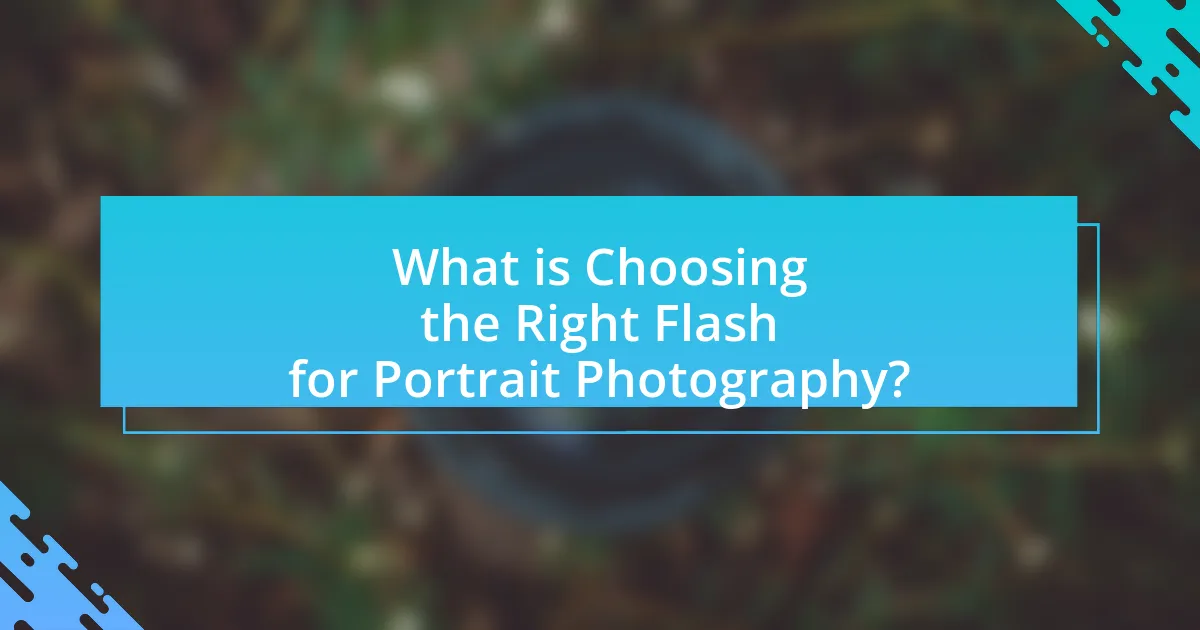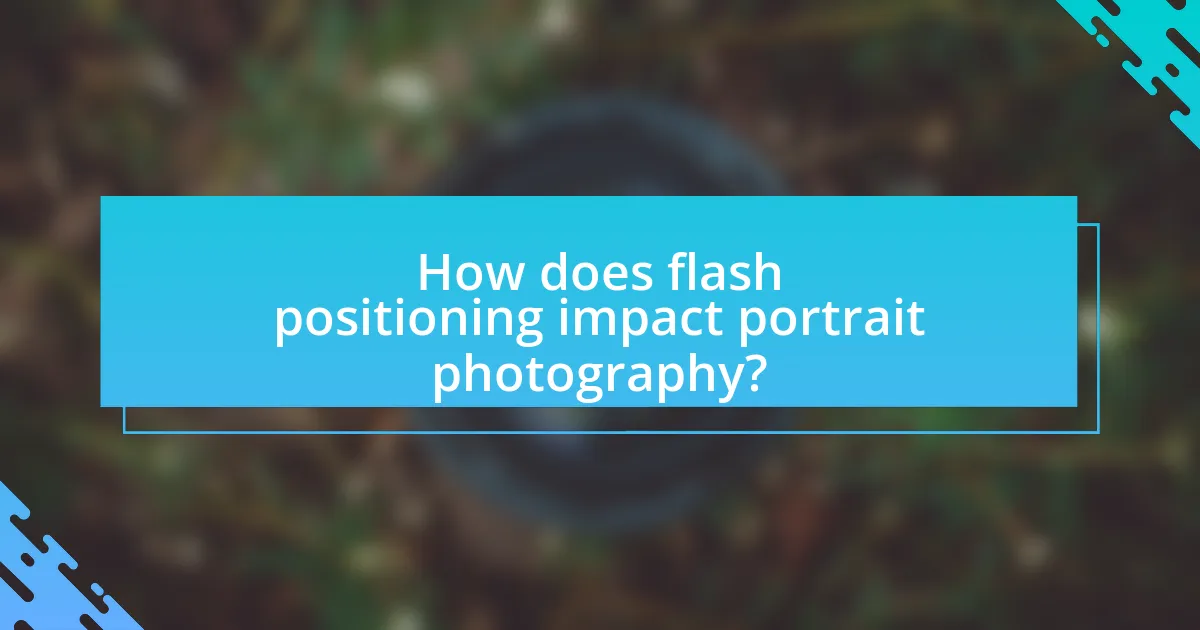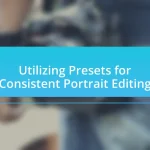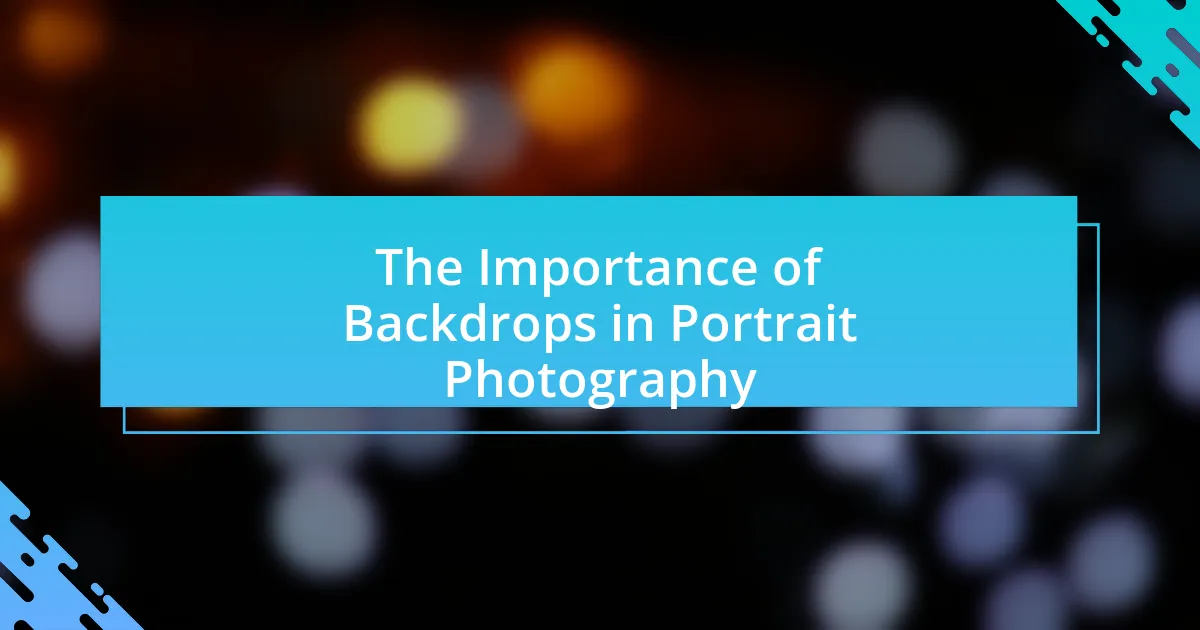Choosing the right flash for portrait photography is essential for achieving well-exposed and flattering images. This article outlines the importance of flash in enhancing subject features and controlling lighting, particularly in challenging environments. It discusses various types of flashes, including speedlights and studio strobes, and highlights key factors to consider when selecting a flash, such as power output and compatibility. Additionally, the article covers effective techniques for using flash, the impact of flash positioning, and the role of modifiers in improving image quality, while also addressing common mistakes to avoid for optimal results in portrait photography.

What is Choosing the Right Flash for Portrait Photography?
Choosing the right flash for portrait photography involves selecting a flash unit that provides adequate lighting, enhances the subject’s features, and complements the shooting environment. A suitable flash should offer adjustable power settings, allowing photographers to control the intensity of light, and should ideally have a softbox or diffuser to soften shadows and reduce harshness. Research indicates that using a flash with a guide number of at least 60 can effectively illuminate subjects in various settings, ensuring well-exposed portraits.
Why is flash important in portrait photography?
Flash is important in portrait photography because it provides controlled lighting that enhances the subject’s features and reduces shadows. Proper use of flash can create a more flattering and dynamic image by illuminating the subject evenly, especially in low-light conditions or when the background is significantly brighter. Studies show that using flash can improve the overall quality of portraits by allowing photographers to manipulate light direction and intensity, resulting in images that are sharper and more vibrant.
What role does lighting play in portrait photography?
Lighting is crucial in portrait photography as it shapes the subject’s appearance and mood. Proper lighting enhances facial features, creates depth, and sets the overall tone of the image. For instance, soft lighting can minimize shadows and create a flattering effect, while harsh lighting can produce dramatic contrasts. Studies show that the direction, quality, and color of light significantly influence how subjects are perceived; for example, Rembrandt lighting is known for its ability to create a three-dimensional look on the face. Thus, understanding and manipulating lighting is essential for achieving desired artistic outcomes in portrait photography.
How does flash enhance the quality of portraits?
Flash enhances the quality of portraits by providing controlled lighting that reduces shadows and highlights facial features effectively. This controlled lighting allows for better exposure, ensuring that details in both highlights and shadows are visible, which is crucial for capturing the subject’s likeness. Additionally, flash can create a catchlight in the eyes, adding depth and life to the portrait. Studies have shown that portraits taken with flash often exhibit improved clarity and contrast compared to those taken in natural light alone, as the flash helps to balance the overall lighting conditions.
What types of flashes are available for portrait photography?
The types of flashes available for portrait photography include speedlights, studio strobes, and continuous lights. Speedlights are portable and versatile, making them ideal for on-location shoots, while studio strobes provide powerful lighting and are commonly used in controlled environments. Continuous lights offer a constant light source, allowing photographers to see how the light affects the subject in real-time. Each type serves different needs and scenarios in portrait photography, ensuring that photographers can achieve the desired lighting effects.
What are the differences between built-in and external flashes?
Built-in flashes are integrated into the camera body, while external flashes are separate units that can be mounted on the camera or used off-camera. Built-in flashes typically have limited power and range, making them suitable for basic lighting needs, whereas external flashes offer greater power, versatility, and features such as adjustable angles and wireless operation. For instance, external flashes can provide more control over lighting conditions, allowing photographers to create more dynamic and professional-looking portraits.
How do speedlights compare to studio strobes?
Speedlights are portable, battery-operated flashes, while studio strobes are larger, AC-powered units designed for stationary use. Speedlights offer convenience and versatility for on-location shoots, allowing photographers to easily adjust their lighting setup. In contrast, studio strobes provide more power and consistent output, making them ideal for controlled environments like studios. Speedlights typically have a lower guide number compared to studio strobes, which means they may not produce as much light intensity, but they are easier to transport and set up quickly. Studio strobes often come with advanced features such as modeling lights and more extensive light modifiers, enhancing creative control over the lighting.
What factors should be considered when choosing a flash?
When choosing a flash, key factors to consider include the flash type, power output, recycling time, and compatibility with your camera system. The type of flash, such as on-camera or off-camera, affects lighting control and versatility in portrait photography. Power output, measured in guide numbers, determines the flash’s ability to illuminate subjects at various distances. Recycling time is crucial for capturing multiple shots in quick succession, as faster recycling allows for more frames per second. Lastly, ensuring compatibility with your camera system guarantees seamless integration and functionality, which is essential for effective portrait lighting.
How does the power output of a flash affect portrait photography?
The power output of a flash significantly influences the exposure and quality of portrait photography. A higher power output allows for greater control over lighting, enabling photographers to illuminate subjects effectively in various environments, including bright outdoor settings or dimly lit indoor spaces. For instance, a flash with a power output of 600Ws can adequately light a subject at a distance of 10 feet, while a lower output of 200Ws may struggle to achieve the same effect, resulting in underexposed images. Additionally, the power output affects the depth of field; higher power settings can create a shallower depth of field by allowing for wider apertures, enhancing the subject’s separation from the background.
What features should you look for in a flash for portraits?
When selecting a flash for portraits, look for features such as adjustable power settings, a softbox or diffuser attachment, and a swivel head. Adjustable power settings allow for precise control over light intensity, which is crucial for achieving the desired exposure and mood in portrait photography. A softbox or diffuser attachment helps to soften the light, reducing harsh shadows and creating a more flattering illumination on the subject’s face. A swivel head enables flexibility in directing light, allowing photographers to bounce the flash off walls or ceilings for a more natural look. These features collectively enhance the quality of portrait lighting, making them essential for effective portrait photography.
How can you effectively use flash in portrait photography?
To effectively use flash in portrait photography, position the flash at an angle to create soft, flattering light on the subject’s face. This technique minimizes harsh shadows and enhances facial features, resulting in a more appealing portrait. Using a diffuser or softbox can further soften the light, making it more natural. Studies show that diffused light reduces contrast and creates a more even skin tone, which is crucial for portrait work. Additionally, adjusting the flash power and using bounce techniques can help achieve the desired exposure without overwhelming the subject with direct light.
What techniques can improve flash photography results?
To improve flash photography results, photographers should utilize techniques such as adjusting the flash power, using diffusers, and employing bounce flash. Adjusting the flash power allows for better exposure control, ensuring that the subject is neither overexposed nor underexposed. Using diffusers softens the light, reducing harsh shadows and creating a more flattering appearance on the subject’s skin. Employing bounce flash, where the flash is directed towards a reflective surface like a ceiling or wall, helps to create a more natural and even light distribution, enhancing the overall quality of the image. These techniques are widely recognized in photography as effective methods for achieving superior results in flash photography.

How does flash positioning impact portrait photography?
Flash positioning significantly impacts portrait photography by influencing the quality of light, shadows, and overall mood of the image. Properly positioned flash can create flattering highlights on the subject’s face, while poor positioning may result in harsh shadows or unflattering reflections. For instance, placing the flash at eye level and slightly to the side can enhance facial features and provide a more three-dimensional look, as supported by the principle that light from above creates natural shadows that define contours. Conversely, direct frontal flash can flatten the subject and produce unappealing results. Therefore, understanding and manipulating flash positioning is crucial for achieving professional-quality portraits.
What are the best angles for positioning a flash?
The best angles for positioning a flash in portrait photography are typically 45 degrees to the side and slightly above the subject’s eye level. This angle creates a natural-looking light that enhances facial features and reduces harsh shadows. Positioning the flash at this angle allows for soft, flattering illumination, which is essential for capturing appealing portraits. Studies in photography emphasize that using a 45-degree angle helps to achieve a three-dimensional effect, making the subject appear more dynamic and engaging.
How does the distance from the subject affect lighting?
The distance from the subject significantly affects lighting by altering the intensity and quality of light that reaches the subject. As the distance increases, the light intensity decreases due to the inverse square law, which states that light intensity diminishes with the square of the distance from the source. For example, if a light source is moved from 1 meter to 2 meters away, the light intensity on the subject is reduced to one-fourth of its original strength. This principle is crucial in portrait photography, as it influences exposure settings and the overall mood of the image.
What is the impact of using multiple flashes in a portrait setup?
Using multiple flashes in a portrait setup enhances lighting control and depth, resulting in more dynamic and visually appealing images. This technique allows photographers to create a balanced exposure by filling shadows, highlighting features, and adding dimension to the subject. For instance, employing a key light, fill light, and backlight can separate the subject from the background, creating a three-dimensional effect. Studies in photography demonstrate that using multiple light sources can significantly improve the quality of portraits by reducing harsh shadows and providing a more flattering illumination.
How can modifiers enhance flash photography?
Modifiers enhance flash photography by controlling the quality and direction of light, resulting in more flattering and professional-looking images. For instance, softboxes diffuse the harsh light from a flash, creating a softer and more even illumination on the subject’s face, which reduces shadows and highlights imperfections. Additionally, reflectors can redirect light to fill in shadows, enhancing the overall exposure and detail in the portrait. Studies have shown that using modifiers can significantly improve the aesthetic quality of photographs, as they allow photographers to manipulate light in a way that complements the subject’s features and the desired mood of the image.
What types of modifiers are most effective for portraits?
Softboxes and umbrellas are the most effective modifiers for portraits. Softboxes provide a controlled, diffused light that reduces harsh shadows and creates a flattering skin tone, while umbrellas offer versatility and portability, allowing for both soft and direct lighting effects. Studies in portrait photography consistently show that diffused light sources enhance the subject’s features and improve overall image quality, making these modifiers essential tools for photographers aiming for professional results.
How do modifiers change the quality of light in portraits?
Modifiers change the quality of light in portraits by altering its softness, direction, and intensity. For instance, softboxes diffuse light, creating a softer, more flattering illumination that reduces harsh shadows on the subject’s face. In contrast, reflectors bounce light, enhancing brightness and adding highlights, which can make the portrait more dynamic. Additionally, grids can narrow the beam of light, allowing for more controlled and dramatic lighting effects. These changes in light quality significantly impact the overall mood and appearance of the portrait, making modifiers essential tools in portrait photography.

What are common mistakes to avoid when using flash for portraits?
Common mistakes to avoid when using flash for portraits include overexposing the subject, using harsh lighting, and failing to consider the background. Overexposure occurs when the flash is too powerful, resulting in loss of detail in highlights. Harsh lighting can create unflattering shadows on the subject’s face, making the portrait look unnatural. Additionally, neglecting the background can lead to distractions or unappealing elements that detract from the subject. Properly balancing flash power, diffusing light, and ensuring a complementary background are essential for achieving high-quality portrait results.
How can overexposure be prevented in flash photography?
Overexposure in flash photography can be prevented by adjusting the flash output and camera settings. Reducing the flash power, using a diffuser, or increasing the shutter speed can help control the amount of light hitting the sensor. Additionally, setting the camera to a lower ISO sensitivity minimizes the sensor’s sensitivity to light, further reducing the risk of overexposure. These methods are supported by the principle that controlling light intensity and exposure settings directly influences the final image quality.
What settings should be adjusted to avoid harsh shadows?
To avoid harsh shadows in portrait photography, adjust the flash power, distance, and angle. Reducing the flash power softens the light, while increasing the distance between the flash and the subject diminishes the intensity of shadows. Additionally, positioning the flash at an angle rather than directly in front of the subject helps to diffuse the light and create a more flattering illumination. These adjustments are supported by the principle that softer light sources produce less defined shadows, enhancing the overall quality of the portrait.
How can you ensure proper color balance in flash photography?
To ensure proper color balance in flash photography, use a color temperature meter or a gray card to set the correct white balance. This method allows photographers to accurately measure the color temperature of the flash and adjust the camera settings accordingly, ensuring that skin tones and other colors appear natural. Research indicates that using a gray card can improve color accuracy by providing a neutral reference point, which is essential for achieving consistent results in portrait photography.
What are some best practices for using flash in portrait photography?
Best practices for using flash in portrait photography include diffusing the light, positioning the flash at an angle, and adjusting the flash power to complement ambient light. Diffusing the light softens shadows and reduces harshness, which is crucial for flattering skin tones. Positioning the flash at an angle, rather than directly in front of the subject, creates depth and dimension in the portrait. Adjusting the flash power ensures that the flash does not overpower the ambient light, maintaining a natural look in the photograph. These techniques are supported by the principles of lighting in photography, which emphasize the importance of soft light and balanced exposure for achieving professional-quality portraits.
How can you practice and improve your flash photography skills?
To practice and improve your flash photography skills, consistently experiment with different flash settings and techniques in various lighting conditions. Engaging in hands-on practice allows you to understand the effects of flash power, duration, and positioning on your subjects. For instance, using a flash in both direct and bounced configurations can demonstrate how light quality changes, enhancing your ability to manipulate shadows and highlights effectively. Additionally, studying the work of professional photographers and replicating their techniques can provide valuable insights into effective flash usage. This method is supported by the fact that practical application and analysis of established techniques lead to skill enhancement in photography.
What tips can help achieve natural-looking portraits with flash?
To achieve natural-looking portraits with flash, use a diffuser to soften the light. A diffuser reduces harsh shadows and creates a more flattering illumination on the subject’s face. Additionally, position the flash off-camera to avoid direct light, which can lead to unflattering results. This technique mimics natural light sources and enhances the overall aesthetic of the portrait. Furthermore, adjusting the flash power to balance with ambient light helps maintain a natural look, ensuring the subject is well-lit without appearing overly bright compared to the background. These methods are supported by photography principles that emphasize the importance of light quality and direction in portraiture.

















